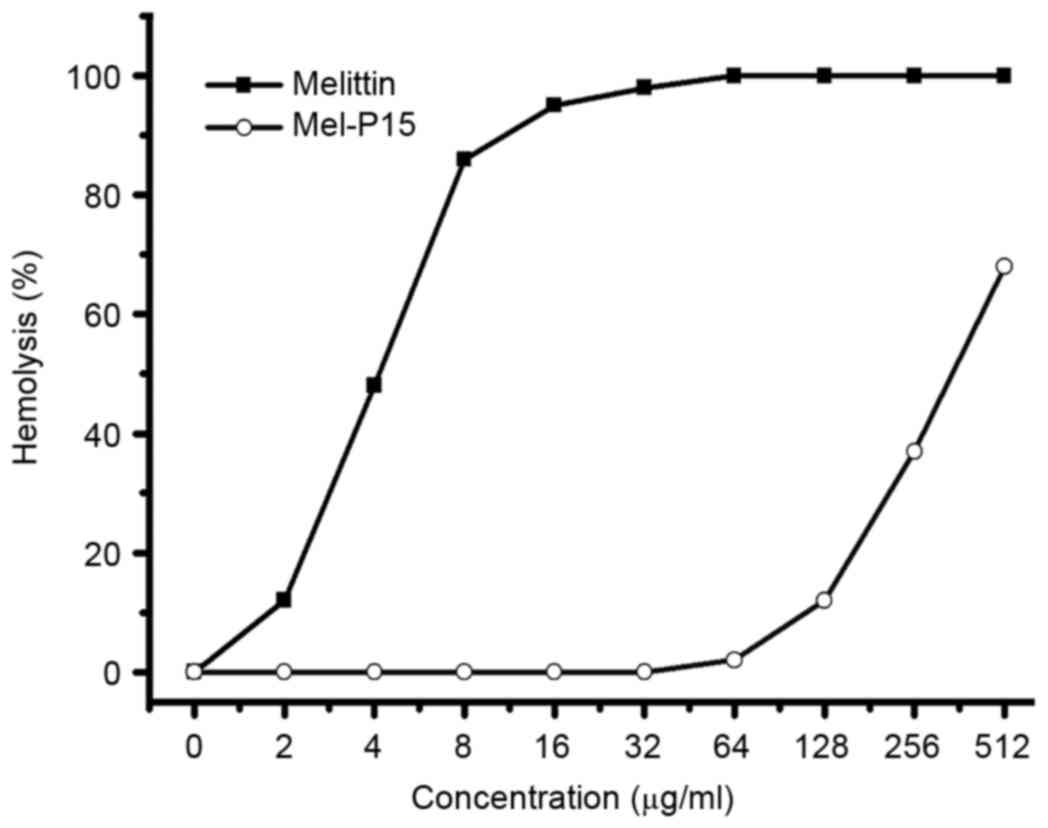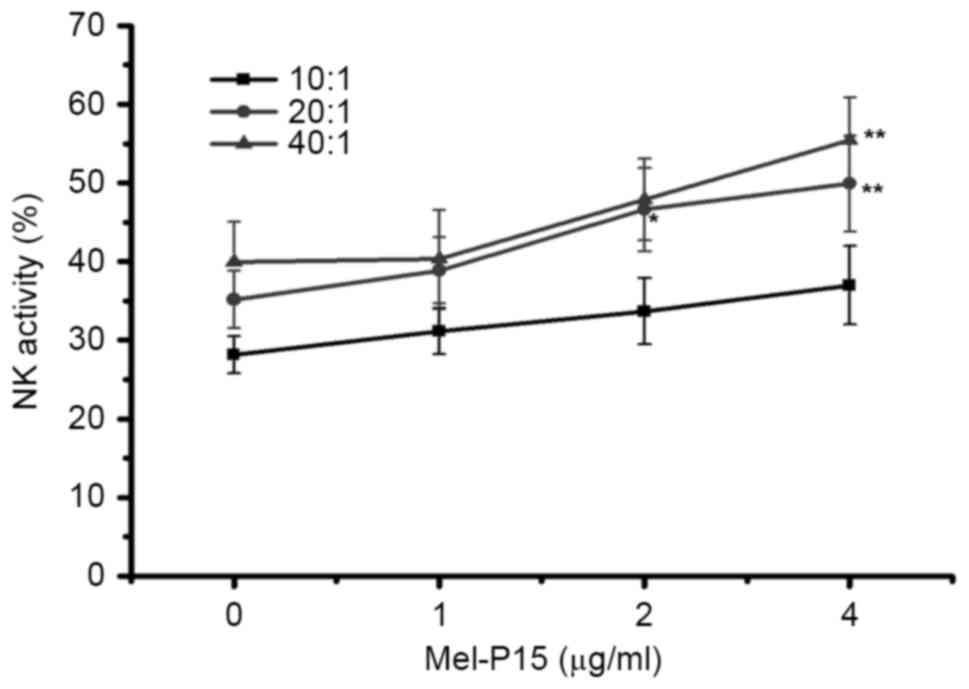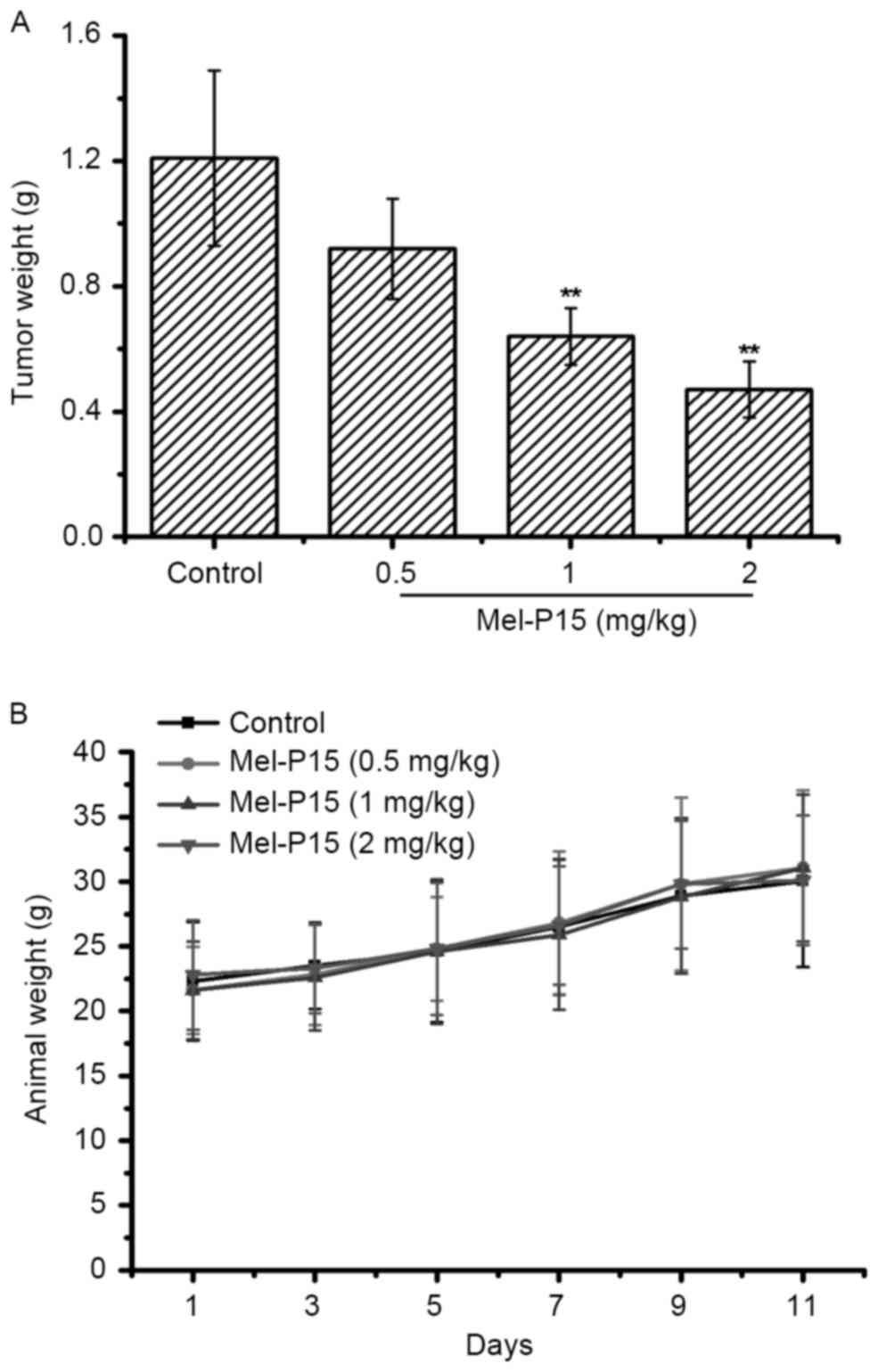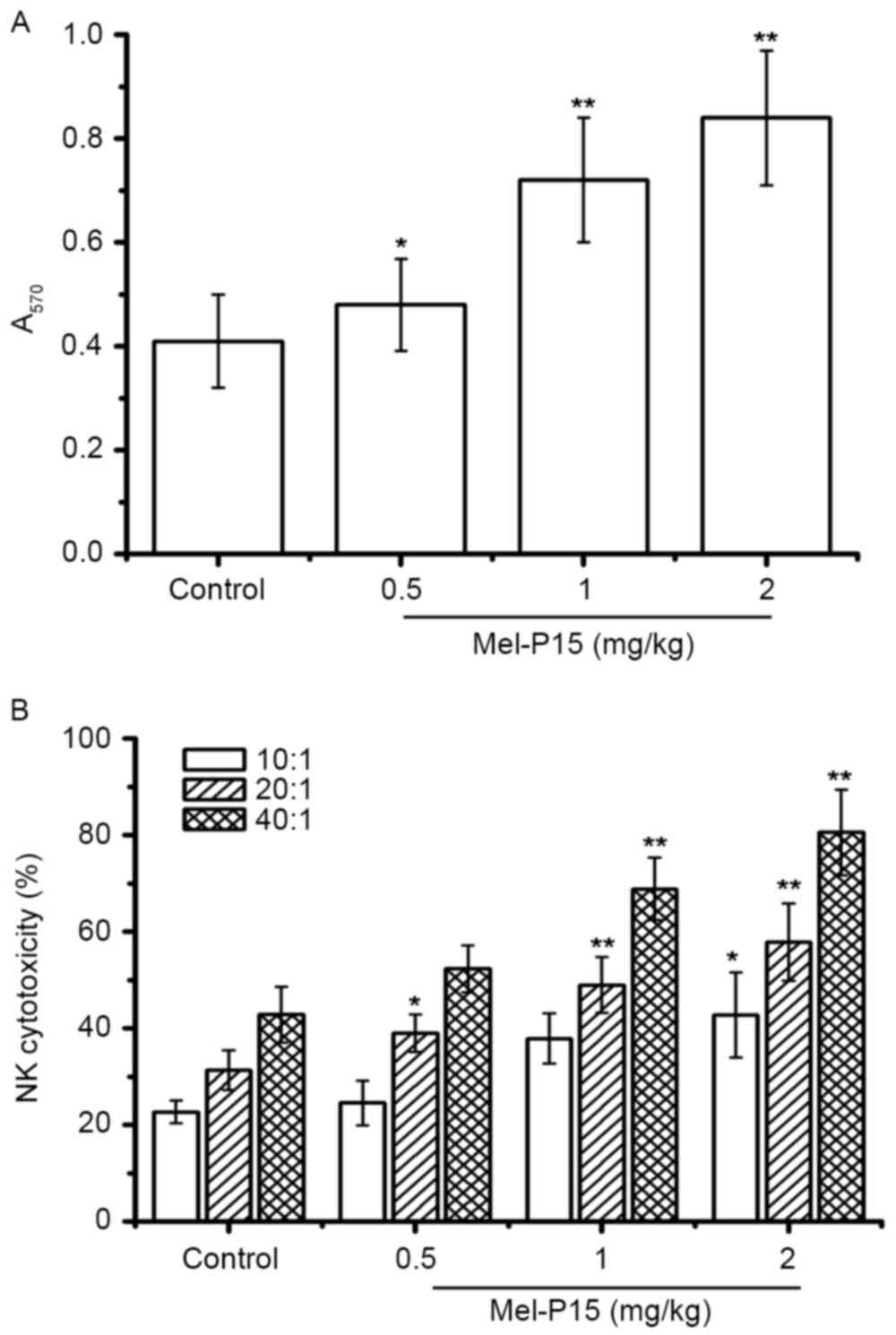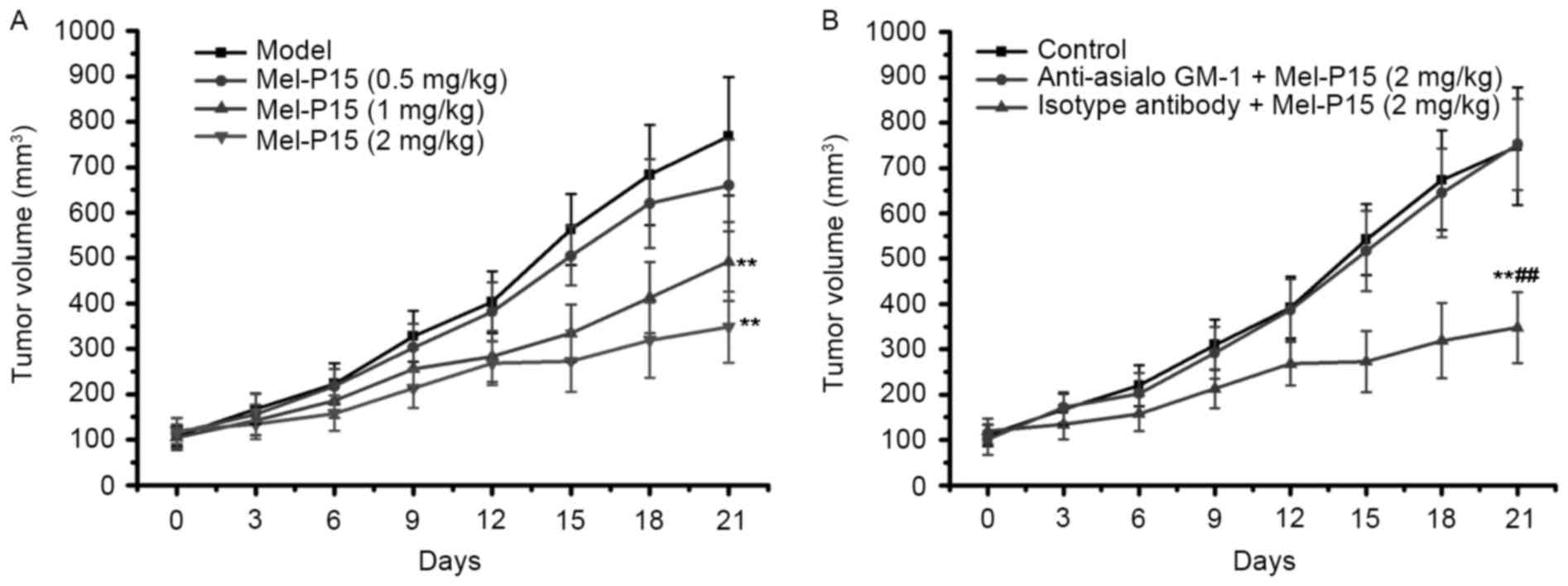The anti‑hepatocellular carcinoma activity of Mel‑P15 is mediated by natural killer cells
- Authors:
- Published online on: September 21, 2017 https://doi.org/10.3892/ol.2017.7018
- Pages: 6901-6906
Abstract
Introduction
Hepatocellular carcinoma (HCC) is one of the most deadly types of cancer worldwide (1). Administration of chemotherapeutic agents is the primary approach in cancer treatment in the clinic; however, severe side effects limit their use and further development (2). Immunomodulatory agents, which stimulate the host immune system, may be a possible method to inhibit tumor growth without harming the host (3,4). Therefore, the identification of novel antitumor treatments with immunomodulatory characteristics is required.
Melittin is the primary toxic component in the venom of the European honeybee (Apis mellifera) (5). Previous studies have demonstrated that melittin, which contains 26 amino acid residues, is a cationic and hemolytic peptide (6). Melittin has been revealed to exhibit a number of biological effects, including anti-bacterial, anti-inflammatory, and anti-tumor effects (5,7–9). The anti-tumor effects of melittin are based on directly killing cancer cells via disruption of the cell membrane or inducing the apoptosis of tumor cells (10–11). Previous studies have reported that melittin exhibits a stimulatory effect on the immune system, indicating its immunomodulatory potential in treating cancer (12,13). In the present study, based on the amphipathic structure of melittin, an analog of melittin (Mel-P15) consisting of 15 amino acids was designed and synthesized. The effects of Mel-P15 on hepatocellular carcinoma were then investigated in vitro and in vivo.
The results from the present study indicated that Mel-P15 directly promotes the natural killer (NK) activity of splenocytes in vitro. Additionally, Mel-P15 inhibited tumor growth in vivo and stimulated the immune system by promoting splenocyte proliferation, increasing the spleen and thymus indices, enhancing NK cell cytotoxicity and upregulating the secretion of interleukin (IL)-2, interferon (IFN)-γ and tumor necrosis factor (TNF)-α in the serum. Mel-P15 exhibited anti-tumor effects in BEL-7402-bearing nude mice, which was abrogated by the selective depletion of the NK cell population via intraperitoneal injection of an anti-asialo-GM-1 antibody. Taken together, these data indicate that the anti-hepatocellular carcinoma activity of Mel-P15 is mediated by promoting NK cell cytotoxicity in vivo.
Materials and methods
Cell lines, reagents and animals
Mel-P15 (amino acid sequence, GLPALISWIKRKRQQ) was synthesized by GL Biochem, Ltd. (Shanghai, China) via stepwise solid phase methodology (14). Then the peptide was purified using a Sephadex™ gel column. The purity was >98% as detected by HPLC.
The mouse H22 and human BEL-7402 hepatocellular carcinoma cell lines were purchased from the American Type Culture Collection (Manassas, VA, USA), the YAC-1 mouse lymphoma cell line was obtained from Nanjing KeyGEN Biotech Co., Ltd. (Nanjing, China). Cells were cultured at 37°C in a humidified atmosphere containing 5% CO2 in RPMI-1640 medium with 10% fetal bovine serum, 100 U/ml penicillin and 100 U/ml streptomycin (all from Gibco; Thermo Fisher Scientific, Inc., Waltham, MA, USA).
Female 6-week-old ICR mice (n=20, 18–22 g) and 4-week-old nude mice (n=24, 16–18 g) were purchased from the Laboratory Animal Center of Yangzhou University (Yangzhou, China). The animals were housed in a rodent facility at 22±1°C with a 12 h light-dark cycle and provided with continuous standard rodent chow and water. All procedures involving animals and their care in the present study were in accordance with protocols approved by the Ethics Committee of Provincial Hospital Affiliated to Shandong University (Jinan, China).
Hemolytic activity assay
The hemolytic activity assay was performed as previously described (15) with modifications. Briefly, sheep blood cells were harvested and washed with PBS. Then, the packed cell volume was used to prepare a 10% (v/v) suspension in PBS. The cell suspension (100 µl) was transferred to tubes and mixed with 100 µl of peptide solution. Tubes were incubated at 37°C for 1 h and centrifuged at 300 × g for 5 min at 4°C. Cells incubated with PBS alone were treated as the negative control. Red blood cells lysed using 0.1% Triton X-100 served as a positive control (100% lysis). The absorbance of the supernatant was measured at 540 nm to monitor blood cell lysis. The percentage of hemolysis was calculated as follows: [(A540 in the peptide solution-A540 in PBS)/(A540 in 0.1% Triton X-100-A540 in PBS)] ×100%.
Cytotoxic activities of NK cells
The cytotoxic activities of NK cells were determined using a CytoTox 96 Non-Radioactive Cytotoxicity Assay kit (Promega Corporation, Madison, WI, USA) as previously described (16). Briefly, splenocytes in each group were treated with YAC-1 cells at effector:target (E:T) ratios of 40:1, 20:1, and 10:1. Following incubation for 4 h, the cytotoxicity was measured.
H22 xenograft mouse model and Mel-P15 administration
In the present study, the H22 xenograft mouse model was established as previously described (17,18). Briefly, seven-day-old H22 ascites (0.1 ml; 5×106 cells) were transplanted subcutaneously into the right axilla of each ICR mouse. A total of 7 days following tumor implantation, the mice were randomly divided into four groups and administered the following: the control group was administered normal saline; the three Mel-P15 groups were administered Mel-P15 (0.5, 1 or 2 mg/kg). Each group contained 10 mice. All of the solutions were dissolved in normal saline, filtered through a 0.22-µm filter (EMD Millipore, Billerica, MA, USA) and administered daily via intraperitoneal injection (200 µl) for 7 days. A total of 24 h after the last drug administration, all animals were weighed and sacrificed by cervical dislocation. The weights of spleens, thymus, and tumor tissues in each group were measured, and the sera were collected to detect IL-2, IFN-γ and TNF-α levels using murine ELISA kits (R&D Systems Inc., Minneapolis, MN, USA).
BEL-7402 xenograft mouse model and Mel-P15 administration in vivo
Human hepatocellular carcinoma BEL-7402 cells were collected at the logarithmic phase of growth and diluted with normal saline, then the cell suspension (5×106 cells) was transplanted subcutaneously into the right axilla of each nude mouse. When the tumors had grown to 100–300 mm3, the mice were randomly divided into four groups: a control group (normal saline) and three Mel-P15-treated groups (0.5, 1 or 2 mg/kg of body weight). Each group contained six mice. Drugs were administered by intraperitoneal injection three times per week. During the three weeks of treatment, the tumor volume of each mouse was measured every three days. Following the final administration, the mice from all of the groups were sacrificed by cervical dislocation 24 h after the final administration. The tumor weights of the mice from each group were measured.
Depletion of the NK cell population in mice
The depletion of NK cells in mice was conducted using an anti-asialo-GM-1 antibody (Wako Pure Chemical Industries, Ltd., Osaka, Japan; catalogue numbe 986-10001) as previously described (19). Briefly, tumor-bearing nude mice were administered 50 µl of anti-asialo-GM-1 antibody by intraperitoneal injection 3 days prior to drug treatment, followed by repeated injection every four days for the following three weeks. The control group received isotype normal rabbit IgG (PeproTech Inc., Rocky Hill, NJ, USA; catalogue number 500-P00) injections. The NK cell populations from the spleens of these mice were analyzed using flow cytometry.
In vivo anti-tumor activity assay
The in vivo antitumor activity was expressed as an inhibitory rate percentage and calculated as follows: [(A-B)/A] ×100%, where A and B were the average weights of the tumors from the control and experimental groups, respectively.
The tumor volume (TV) was measured and calculated using the following formula: TV=1/2 × a × b2, where a and b were the long and short diameters of the tumors in each mouse, respectively.
The spleen or thymus index was calculated as the spleen (or thymus) weight/body weight.
Splenocyte proliferation assay
Mouse spleens were collected from mice in each group under aseptic conditions, then were gently homogenized and passed through a 300-mesh sieve to obtain single-cell suspensions. Following treatment with erythrocyte lysis buffer (Beyotime Institute of Biotechnology, Haimen, China), the cells were washed with normal saline and resuspended in RPMI-1640 medium, which contained 10% fetal bovine serum. Then the cell suspension (5×106 cells/ml) was seeded in a 96-well flat-bottomed microplate in triplicate at 100 µl/well, and either 5 µg/ml concanavalin A (Sigma-Aldrich; Merck KGaA, Darmstadt, Germany; catalogue number L6397) or 4 µg/ml lipopolysaccharide (Sigma-Aldrich; Merck KGaA; catalogue number L2637) was added to the wells. The cells were then cultured for 44 h at 37°C in a humidified, 5% CO2 atmosphere and further incubated for 4 h with MTT solution (20 µl/well; 5 mg/ml). The cells were lysed, and the purple formazan crystals were solubilized using dimethylsulfoxide (Sigma-Aldrich; Merck KGaA) for detection at 570 nm as measured by a microplate reader (Model 6800; Bio-Rad Laboratories, Inc., Hercules, CA, USA).
Statistical analysis
All of the experiments in the present study were performed at least three times. The data are presented as the mean ± standard deviation. Statistical analysis was performed using a one-way analysis of variance (followed by Dunnett's test) or a Student's t-test. P<0.05 was considered to indicate a statistically significant difference.
Results
Hemolytic activity of Mel-P15
The hemolytic activity of a peptide against red blood cells is typically used as a primary assay to test the toxicity of a peptide (20). Mel-P15 exhibited a relatively low hemolytic activity within the range of 0–128 µg/ml, whereas melittin exhibited clear hemolytic effects even at low concentrations (Fig. 1).
Mel-P15 directly stimulates the cytotoxicity of NK cells in vitro
When cells were mixed at an E:T ratio of 20:1 or 40:1, Mel-P15 significantly promoted the activity of NK cells in vitro when administered at a concentration of 4 µM compared with the control (0 µM) group (P<0.01; Fig. 2). Following treatment with 4 µg/ml Mel-P15, NK cytotoxicity was increased to 35.72, 49.92 and 55.45% at E:T ratios of 10:1, 20:1 and 40:1, respectively.
Mel-P15 administration effectively inhibits the growth of tumors in H22-bearing mice
The tumor weights in each group were measured to evaluate the inhibitory effect of Mel-P15 on the growth of the transplanted H22 carcinoma. Mel-P15 significantly inhibited the growth of H22 hepatomas in vivo in a dose-dependent manner compared with the control, with an inhibitory rate of 23.97, 47.11 and 61.51% for 0.5, 1 and 2 mg/kg Mel-P15, respectively (P<0.01 for 1 and 2 mg/kg Mel-P15; Fig. 3A). Additionally, treatment with Mel-P15 did not significantly change the body weight of tumor-bearing mice compared with the control mice, suggesting that Mel-P15 does not exhibit marked toxicity in vivo (Fig. 3B).
Mel-P15 promotes the immune response in vivo
In order to investigate the effect of Mel-P15 on the immune system in H22-bearing mice, the spleen and thymus indices were measured. The results obtained indicated that Mel-P15 significantly increased the indices of spleens and thymuses at doses of 1 or 2 mg/kg (P<0.05 and P<0.01, respectively for the spleen and P<0.01 and P<0.01, respectively for the thymus; Table I). In particular, at a dose of 2 mg/kg, the spleen and thymus indices were increased 1.47- and 1.39-fold, respectively, compared with the control group. Additionally, Mel-P15 significantly promoted splenocyte proliferation in vivo in a dose-dependent manner (P<0.05, P<0.01 and P<0.01 for 0.5, 1 and 2 mg/kg, respectively; Fig. 4A). The splenocyte proliferation rates were 1.17-, 1.76- and 2.05-fold following treatment with 0.5, 1 and 2 mg/kg Mel-P15, respectively, compared with the control group.
Mel-P15 may stimulate NK cells in vitro; therefore the cytotoxicity of NK cells in vivo was measured. The results indicated that NK cytotoxicity was increased in an E:T ratio- and Mel-P15 dose-dependent manner (Fig. 4B). In particular, at an E:T ratio of 40:1, the NK cytotoxicity was 52.43, 68.89 and 80.56% following treatment with 0.5, 1 and 2 mg/kg Mel-P15, respectively.
TNF-α, IL-2 and IFN-γ levels in the sera of H22-bearing mice were significantly increased in a dose-dependent manner following Mel-P15 administration (Fig. 5A-C). Following treatment with 2 mg/kg Mel-P15, the levels of TNF-α, IL-2 and IFN-γ were 1.38-, 2.57- and 1.49-fold, respectively, compared with the control group. Taken together, these results suggested that the inhibition of tumor growth by Mel-P15 in vivo was mediated partly by stimulating the immune response.
Depletion of NK cells impairs the antitumor effects of Mel-P15 in BEL-7402-bearing nude mice
As Mel-P15 treatment significantly prevented the growth of mouse H22 hepatocarcinoma in vivo, the effect of Mel-P15 on BEL-7402 tumor growth was further studied in nude mice. The results demonstrated that Mel-P15 significantly inhibited tumor growth in BEL-7402-bearing mice in a dose-dependent manner (Fig. 6A). However, when NK cells were depleted in BEL-7402-bearing nude mice by intraperitoneal injection of anti-asialo-GM1 antibody, the effect of Mel-P15 on BEL-7402 tumor growth was almost completely abolished (Fig. 6B). Taken together, the results indicated that NK cytotoxicity serves a role in the anti-hepatocarcinoma effects of Mel-P15.
Discussion
Hepatocarcinoma is one of the most common types of malignant cancer and has been associated with high fatality rates in humans (1). In the clinic, one of the primary treatments is chemotherapy, which causes adverse side effects (21). Therefore, novel treatments are required to treat hepatocarcinoma.
Among the novel candidate drugs, antimicrobial peptides have attracted attention due to their decreased likelihood of drug resistance and low cytotoxicity (22). Melittin, a natural antibacterial peptide, has been demonstrated to possess broad-spectrum antimicrobial, antiviral and antitumor effects (7–9). In the present study, based on the structure of melittin, a new peptide was designed and named Mel-P15. The whole sequence of Mel-P15 was GLPALISWIKRKRQQ, which consisted of 15 amino acids. Then the anti-tumor activity and underlying molecular mechanisms of the effects of Mel-P15 were investigated.
First, the toxicity of Mel-P15 in vitro was studied. The hemolytic activity of Mel-P15 indicated that for doses up to 128 µg/ml, Mel-P15 exhibited low toxicity on eukaryotic cells. However, for melittin, at the concentration of 10 µg/ml, the hemolytic activity reached ~70%, which was higher compared with that of Mel-P15. The data indicated that Mel-P15 exhibited a lower cytotoxicity on eukaryotic cells compared with melittin.
In a mouse H22 hepatocarcinoma xenograft tumor model, Mel-P15 inhibited tumor growth in vivo and increased the spleen and thymus indices. Further investigated indicated that Mel-P15 activates the immune system by promoting splenocyte proliferation, NK cell cytotoxicity and cytokine secretion, including that of IFN-γ, TNF-α and IL-2. These findings suggested that the anti-H22 effects of Mel-P15 may be the result of enhanced immune responses in vivo.
The immune system serves an important role in antitumor defenses via cytotoxic lymphocyte T cells and NK cells (23–25). NK cells possess a number of biological activities; NK cells not only directly recognize and lyse cancer cells, but also initiate anti-tumor immune responses by secreting a number of cytokines, including IFN-γ and TNF-α (26). In the present study, Mel-P15 directly stimulated NK cytotoxicity in vitro. In addition, NK activity was markedly induced in H22-bearing mice following Mel-P15 administration. A BEL-7402-bearing nude mice model, which lacks T cells (and therefore for which NK cells are important for the immune response), was established. The results demonstrated that tumor growth was inhibited in a dose-dependent manner in the Mel-P15-treated group. Taken together, these results indicate that NK cells are important in mediating the anti-tumor effects of Mel-P15. In order to confirm this hypothesis, NK cells were depleted by pre-treatment with an anti-asialo-GM-1 antibody, which almost completely impaired the Mel-P15-induced suppression of tumor growth. These results suggest that Mel-P15-enhances NK cytotoxicity in tumor bearing mice.
Cytokines serve a vital role in the immune response to tumor cells, including IFN-γ, TNF-α and IL-2; in particular, IFN-γ may enhance the activity of NK cells against intracellular pathogens and tumor cells (27,28). Additionally, IL-2 may promote the proliferation and cytotoxicity of NK cells (29). In H22-bearing mice, the secretion of IFN-γ, TNF-α and IL-2 was elevated following Mel-P15 administration, suggesting that Mel-P15 increased the secretion of IL-2 and IFN-γ in tumor-bearing mice, thereby activating and maintaining the cytotoxicity of NK cells and eliminating H22 cells.
In conclusion, the data from the present study demonstrated that Mel-P15, a novel analogue derived from melittin, not only inhibited tumor growth in vivo, but also stimulated the immune system by enhancing NK activity, increasing the spleen and thymus indices and promoting the release of cytokines, including IL-2, IFN-γ and TNF-α. Additionally, the antitumor effect of Mel-P15 in vivo was impaired when NK cells were depleted using an anti-asialo GM-1 antibody. Traditional chemotherapy drugs exhibit severe side effects; Mel-P15, which activates the immune system, may decrease the toxicity of chemotherapy in vivo. In the future, Mel-P15 may potentially be used as a complementary drug or protective immunotherapeutic agent for the treatment of cancer.
Acknowledgements
The present study was financially supported by grants from the Scientific and Technological Support & Social Development Plan of Shandong Province (grant no. 2014GGB1422).
References
|
Chen W, Zheng R, Baade PD, Zhang S, Zeng H, Bray F, Jemal A, Yu XQ and He J: Cancer statistics in China, 2015. CA Cancer J Clin. 66:115–132. 2016. View Article : Google Scholar : PubMed/NCBI | |
|
Wu C, Geng X, Wan S, Hou H, Yu F, Jia B and Wang L: Cecropin-P17, an analog of Cecropin B, inhibits human hepatocellular carcinoma cell HepG-2 proliferation via regulation of ROS, Caspase, Bax, and Bcl-2. J Pept Sci. 21:661–668. 2015. View Article : Google Scholar : PubMed/NCBI | |
|
McMillin DW and Mitsiades CS: High-throughput approaches to discover novel immunomodulat immunomodulatory agents for cancer. Oncoimmunology. 1:1406–1408. 2012. View Article : Google Scholar : PubMed/NCBI | |
|
Kurtin SE and Bilotti E: Novel agents for the treatment of multiple myeloma: Proteasome inhibitors and immunomodulatory agents. J Adv Pract Oncol. 4:307–321. 2013.PubMed/NCBI | |
|
Fletcher JE and Jiang MS: Possible mechanisms of action of cobra snake venom cardiotoxins and bee venom melittin. Toxicon. 31:669–695. 1993. View Article : Google Scholar : PubMed/NCBI | |
|
Bechinger B: Structure and functions of channel-forming peptides: Magainins, cecropins, melittin and alamethicin. J Membr Biol. 156:197–211. 1997. View Article : Google Scholar : PubMed/NCBI | |
|
Raghuraman H and Chattopadhyay A: Melittin: A membrane-active peptide with diverse functions. Biosci Rep. 27:189–223. 2007. View Article : Google Scholar : PubMed/NCBI | |
|
Choi JH, Jang AY, Lin S, Lim S, Kim D, Park K, Han SM, Yeo JH and Seo HS: Melittin, a honeybee venom-derived antimicrobial peptide, may target methicillin-resistant Staphylococcus aureus. Mol Med Rep. 12:6483–6490. 2015. View Article : Google Scholar : PubMed/NCBI | |
|
Wu X, Zhao B, Cheng Y, Yang Y, Huang C, Meng X, Wu B, Zhang L, Lv X and Li J: Melittin induces PTCH1 expression by down-regulating MeCP2 in human hepatocellular carcinoma SMMC-7721 cells. Toxicol Appl Pharmacol. 288:74–83. 2015. View Article : Google Scholar : PubMed/NCBI | |
|
Wang C, Chen T, Zhang N, Yang M, Li B, Lü X, Cao X and Ling C: Melittin, a major component of bee venom, sensitizes human hepatocellular carcinoma cells to tumor necrosis factor-related apoptosis-inducing ligand (TRAIL)-induced apoptosis by activating CaMKII-TAK1-JNK/p38 and inhibiting IkappaBalpha kinase-NFkappaB. J Biol Chem. 284:3804–3813. 2009. View Article : Google Scholar : PubMed/NCBI | |
|
Lee J and Lee DG: Melittin triggers apoptosis in Candida albicans through the reactive oxygen species-mediated mitochondria/caspase-dependent pathway. FEMS Microbiol Lett. 355:36–42. 2014. View Article : Google Scholar : PubMed/NCBI | |
|
Oršolić N: Bee venom in cancer therapy. Cancer Metastasis Rev. 31:173–194. 2012. View Article : Google Scholar : PubMed/NCBI | |
|
Dezfuli HT, Shahbazzadeh D, Eidi A, Bagheri KP, Pakravan N, Amini S, Aghasadeghi MR and Mahdavi M: Induction of IFN-γ cytokine response against hepatitis B surface antigen using melittin. Gastroenterol Hepatol Bed Bench. 7:108–117. 2014.PubMed/NCBI | |
|
Antopolsky M, Azhayeva E, Tengvall U and Azhayev A: Towards a general method for the stepwise solid-phase synthesis of peptide-oligonucleotide conjugates. Tetrahedron Lett. 43:527–530. 2002. View Article : Google Scholar | |
|
Tu J, Wu G, Zuo Y, Zhao L and Wang S: ZL-2, a cathelicidin-derived antimicrobial peptide, has a broad antimicrobial activity against gram-positive bacteria and gram-negative bacteria in vitro and in vivo. Arch Pharm Res. 38:1802–1809. 2015. View Article : Google Scholar : PubMed/NCBI | |
|
Harakeh S, Azar R, Azhar E, Damanhouri GA, Assidi M, Abu-Elmagd M, Alqahtani MH, Kumosani T, Niedzwiecki A, Rath M, et al: Pecific nutrient combination effects on tax, NF-κB and MMP-9 in human T-cell lymphotropic virus-1 positive malignant T-lymphocytes. BMC Cancer. 15 Suppl 1:S22015. View Article : Google Scholar : PubMed/NCBI | |
|
Li C, Wu X, Zhang H, Yang G, Hao M, Sheng S, Sun Y, Long J, Hu C, Sun X, et al: A Huaier polysaccharide inhibits hepatocellular carcinoma growth and metastasis. Tumour Biol. 36:1739–1745. 2015. View Article : Google Scholar : PubMed/NCBI | |
|
Zhang XY, Qiao H, Ni JM, Shi YB and Qiang Y: Preparation of isoliquiritigenin-loaded nanostructured lipid carrier and the in vivo evaluation in tumor-bearing mice. Eur J Pharm Sci. 49:411–422. 2013. View Article : Google Scholar : PubMed/NCBI | |
|
Huo L, Yao H, Wang X, Wong GW, Kung HF and Lin MC: Inhibition of melanoma growth by subcutaneous administration of hTERTC27 viral cocktail in C57BL/6 mice. PLoS One. 5:e127052010. View Article : Google Scholar : PubMed/NCBI | |
|
Sheng M, Zhao Y, Zhang A, Wang L and Zhang G: The effect of LfcinB9 on human ovarian cancer cell SK-OV-3 is mediated by inducing apoptosis. J Pept Sci. 20:803–810. 2014. View Article : Google Scholar : PubMed/NCBI | |
|
Daniel D and Crawford J: Myelotoxicity from chemotherapy. Semin Oncol. 33:74–85. 2006. View Article : Google Scholar : PubMed/NCBI | |
|
Kang W, Liu H, Ma L, Wang M, Wei S, Sun P, Jiang M, Guo M, Zhou C and Dou J: Effective antimicrobial activity of a peptide mutant Cbf-14-2 against penicillin-resistant bacteria based on its unnatural amino acids. Eur J Pharm Sci. 105:169–177. 2017. View Article : Google Scholar : PubMed/NCBI | |
|
Zhou Z, Yu X, Zhang J, Tian Z and Zhang C: TLR7/8 agonists promote NK-DC cross-talk to enhance NK cell anti-tumor effects in hepatocellular carcinoma. Cancer Lett. 369:298–306. 2015. View Article : Google Scholar : PubMed/NCBI | |
|
McDowell KA, Hank JA, DeSantes KB, Capitini CM, Otto M and Sondel PM: NK cell-based immunotherapies in pediatric oncology. J Pediatr Hematol Oncol. 37:79–93. 2015. View Article : Google Scholar : PubMed/NCBI | |
|
Woo SR, Corrales L and Gajewski TF: Innate immune recognition of cancer. Annu Rev Immunol. 33:445–474. 2015. View Article : Google Scholar : PubMed/NCBI | |
|
Ke M, Wang H, Zhang M, Tian Y, Wang Y, Li B, Yu J, Dou J, Xi T and Zhou C: The anti-lung cancer activity of SEP is mediated by the activation and cytotoxicity of NK cells via TLR2/4 in vivo. Biochem Pharmacol. 89:119–130. 2015. View Article : Google Scholar | |
|
Schoenborn JR and Wilson CB: Regulation of Interferon-gamma during innate and adaptive immune responses. Adv Immunol. 96:41–101. 2007. View Article : Google Scholar : PubMed/NCBI | |
|
Balachandran S and Adams GP: Interferon-γ-induced necrosis: An antitumor biotherapeutic perspective. J Interferon Cytokine Res. 33:171–180. 2013. View Article : Google Scholar : PubMed/NCBI | |
|
García-Cuesta EM, López-Cobo S, Álvarez-Maestro M, Esteso G, Romera-Cárdenas G, Rey M, Cassady-Cain RL, Linares A, Valés-Gómez A, Reyburn HT, et al: NKG2D is a key receptor for recognition of bladder cancer cells by IL-2-activated NK cells and BCG promotes NK cell activation. Front Immunol. 6:2842015.PubMed/NCBI |



